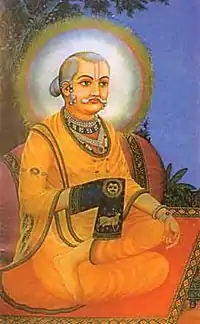Vitthalanatha
Vitthala-natha or Vitthalanath (IAST: Viṭṭhalanātha, c. 1516–1588), popularly known as Gusainji, was an Indian philosopher. He was the younger son of Vallabhacharya, who founded the Pushtimarg religious sect of Hinduism.
Vitthalanath | |
|---|---|
 | |
| Born | c. 1516 Charanat near Varanasi, India |
| Died | c. 1588 |
| Era | Ancient philosophy |
| Region | Indian philosophy |
| School | Hindu philosophy, Shuddhadvaita, Pushtimarg, Vedanta |
Names
The name Vitthalanatha islanguages|schwa deletion]]. His other names include Vitthaleshvara (IAST: Viṭṭhaleśvara), Vitthala Dikshita, or Agnikumara.[1] In addition, he is known by the title Gosvami (Gosain-ji or Gusain-ji).[2]
Early life
Vitthalanatha was born around 1516 (between 1515 and 1518[2]), as the second son of the religious scholar Vallabha.[1]
His devotees consider him an incarnation of the god Vithoba (Vitthal) of Pandharpur.[2] He was brought up by Vallabha till the age of 15, and after that, by Vallabha's disciple Damodara-dasa.[1]
He was proficient in the Vedas, the Brahma Sutra, and the Mimansa philosophy. He studied nyaya at Navadvipa.[2]
Religious activities
After the death of his father Vallabhācārya(c. 1530), Viṭṭhalanātha's elder brother Gopinātha became the leader of the sect. However when Gopinātha died in 1542 with his son Puruṣottama still a minor, Viṭṭhalanātha emerged as the main leader of the religious sect established by his father. Six years later he faced a challenge by Puruṣottam and his family, who was backed by Kr̥ṣṇadāsa Adhikāri, the first temple manager of the Śrī Nāthajī Temple.[3][4]
Kr̥ṣṇadāsa often had controversial relationships with women, and once allowed a wealthy kṣatriya woman named Gaṅgābāī Kṣatrānī to be present during the private offerings of food to Śrī Nāthajī. This was ritually prohibited and Viṭṭhalanātha banned the woman from the temple premises. However in retaliation Kr̥ṣṇadās had Viṭṭhalanātha banned from the temple for a period that would last six months. Viṭṭhalanātha's eldest son Giridhara then petitioned with local Mughal authorities who had Kr̥ṣṇadāsa arrested. However Viṭṭhalanātha demanded that Kr̥ṣṇadāsa be released, and the two reconciled with Viṭṭhalanātha being reinstated as the head of the sect and Kr̥ṣṇadāsa as temple manager. Puruṣottam would later die at a young age.[3]
Vitthalanatha propagated the teachings of his father, and established a religious centre at Gokul.[2]
Literary works
The texts and commentaries attributed to Vitthala include:[2][5]
- Arya
- Avatarataratamya-stotra
- Bhakti-hamsa
- Bhakti-hetu-nirnaya
- Gita-govinda-prathamashtapadi-vivriti
- Jalabheda-tika
- Krishna-premamrita
- Nyasa-desha-vivarana-prabodha
- Premamrita-bhashya
- Shringara-rasa-mandanam (Śr̥ṅgāra-rasa-maṇḍanam)
- Vidvan-Mandanam (Vidvan-maṇḍanam)
- Vidya-mandana
References
- G. V. Devasthali 1977, p. x.
- Roshen Dalal 2014, p. 1375.
- Saha 2004, p. 119, 134-138.
- Barz 1992, p. 235-248.
- B. K. Bhatt 1980, p. 154.
Bibliography
- B. K. Bhatt (1980). Vallabhacharya. Abul Kalam Azad Oriental Research Institute. OCLC 567834413.
- G. V. Devasthali, ed. (1977). Śr̥ṅgāra-rasa-maṇḍanam. Bhandarkar Oriental Research Institute. OCLC 644448135.
- Richard Keith Barz (1976). The Bhakti Sect of Vallabhācārya. Thomson. ISBN 9788121505765. OCLC 29277626.
- Roshen Dalal (2014). Hinduism: An Alphabetical Guide. Penguin Books. ISBN 978-81-8475-277-9.